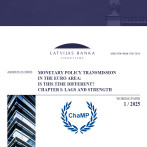Money Supply Resumes Growth
In May, the economic growth trends as well as the stable condition of the banking system and financial market overall found their reflection in a rise in money supply which restarted after a two-month decline. The increase in resident bank deposits in both lats and foreign currencies was quite substantial, whereas the demand for cash remained almost unchanged. No substantial changes have affected the lending market as yet, while the bank loan portfolio contracted in May (–0.3%), reaching a low not observed since August 2010.
Monetary aggregate M3, a measure of cash and non-cash instruments in the economy, grew in May by 1.4%, with M3 annual growth rate accelerating to 6.2%. The amount of bank deposits also increased (to 3.1%) and so did the annual growth rate of currency in circulation (to 14.3%). The rise in M3 took place on account of a strong increase in overnight deposits and somewhat slower time deposit growth, with deposits redeemable at notice at the same time still on a downward trend. In May, enterprise deposits expanded notably, while those of households grew slightly.
The negligible drop in domestic loans notwithstanding, the annual rate of decrease in domestic loans even accelerated somewhat (to 9.1%) due to the base effect in May. The decrease in loans in euro retained the previous rate, whereas the declining interest rates on loans in lats, coupled with higher euro interest rate expectations, determined quite a steep rise in loans in lats. In May, the overall amount of loans in lats picked up 5.6%, while loans in lats to enterprises even grew by 11.9%. Thus in May, the annual rate of change in loans in lats re-entered a positive territory for the first time since the summer of 2007, while the share of loans in lats in total loans went up to 8.9%.
However, the growth has not been buoyant and convincing in all sectors, yet an increasing number of macroeconomic indicators suggest that the economic situation is becoming more balanced overall. This is well confirmed by the recent upgrading of Latvia's credit rating outlook by Moody's and Latvia's successful emission of long-term government bonds in international financial markets. In line with contracting unemployment and moderately growing labour remuneration, the gradually reviving domestic demand supports an increase in money supply. Although the domestic political uncertainty is supposed to linger well into the autumn, its effects could be minimised by quality efforts by both leaving and next governments to prepare the 2012 budget without any deviation from the budget deficit commitment (2.5% of GDP). Hand in hand with fiscal certainty, lending processes will also gain additional security, currently ascertained by growing activity in lending in lats and a halt in the declining enterprise lending as positive signals. A favourable market recovery outlook within the coming year is supported by tightening competition within the banking sector, with several new market participants amplifying their activities in the domestic lending market, and stabilisation of credit portfolio quality indicators.
Textual error
«… …»






